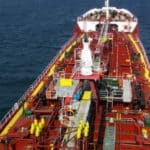Product Tankers: Clean Product Exports from the Middle East and China on the Rise

The product tanker market hasn’t seen the benefits of increased Middle East clean product exports, rate-wise. In its latest weekly report, shipbroker Gibson said that “this year has seen a major increase in the Middle East clean product exports to Europe, with flows, mainly gasoil and jet, averaging at 0.82mbd for the year to date, up by 43% compared to the same period last year. Such an increase was not unexpected, considering increasing runs at the 400 kbd Jizan refinery and 615kbd Al Zour plant, where the final 200kbd crude distillation unit was brought online just a few months ago. Europe, on the other hand, has been working hard to find an alternative source of its CPP import requirement, following the introduction of EU ban on imports of Russian products”.

Source: Gibson Shipbrokers
According to Gibson, “what is surprising, however, is relatively weaker clean tanker rates and earnings over the summer period. Although the rebound has been seen more recently, yearly lows were reached in July 23 on all benchmark trades originating from the Middle East, where robust regional exports were more than offset by higher tonnage availability, particularly for larger LRs. In part, this is explained by a lack of SE Asia and Far East diesel and jet shipments into the Atlantic Basin as well as low West to East naphtha flows during the 2nd quarter of the year. With these shipments being considerably longer haul, the fall in trading volumes here boosted Middle East availability”.
“Looking forward, although some temporary disruption to Middle East flows is likely as some regional plants move into maintenance, Middle East CPP exports will continue to increase in the months ahead. The Al Zour plant still hasn’t reached its full export capacity, whilst the newly commissioned 215kbd Duqm plant has exported its first diesel cargo earlier this month. Additional diesel demand into Europe is also likely. ARA gasoil inventories have been steadily declining in recent months, falling close to their lowest level this year due to stronger domestic demand over summer months and unplanned refinery outages. Inventories are likely to remain under downward pressure over the next couple of months, with some European refineries heading into maintenance in September/October. Also, an outage reported earlier in the week at the 400kbd Pernis refinery, the largest refinery in Europe, highlights the risk of potential unplanned disruptions. Strong heating demand also could offer an element of support, whilst incremental gas-to-oil demand could not be ruled out, particularly if upward pressure on gas prices remains”, Gibson said.
Additionally, “in terms of longer haul flows, tightening European gasoil supply could aid the East/West gasoil arbitrage between SE Asia and the Far East into Europe. Price differentials between the two regions have widened in Aug/Sep but still largely remain insufficient for large scale opportunities, similar to those seen during the final four/five months of last year. With a number of Japanese refineries also going into maintenance in Sep/Oct, regional inventories could be negatively impacted; the latest Russian ban on exports of gasoline and diesel could also cause some temporary havoc. However, much depends on the volume of Chinese product exports. The Chinese government has recently released a third batch of product exports, bringing 2023 total for the year to date some 15% above last year’s CPP total volume. Exports have been edging up as result and there still remains a possibility of another batch of export quotas later in the year. Chinese refineries processed a record level of crude in August but if domestic demand continues to disappoint, the government may be prompted to issue additional quotas, which are likely to lead to a further growth in Chinese product exports, potentially flooding the regional market, with excess exported into the Atlantic Basin”, the shipbroker concluded.
Nikos Roussanoglou, Hellenic Shipping News Worldwide

